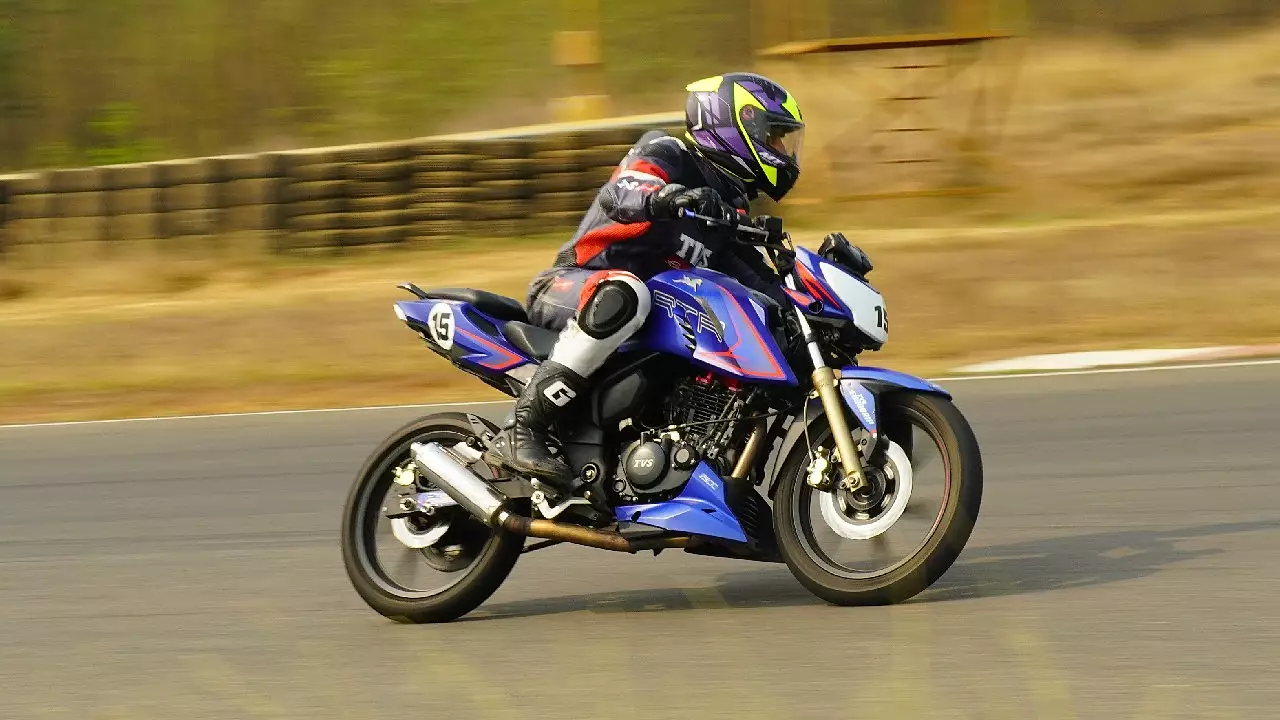BLOG : TVS Young Media Racer Program 6.0 – Unlearn, Learn and Execute

At the start of the year, I pledged to myself and the family that come what may, a track day or two are on the charts for me in 2022. Well, that’s all it was, a pledge with no direction or actions. Come April ‘22, my colleague Pratheek Kunder tells me that I’ll be a part of the 2022 TVS Young Media Racer Program (YMRP). And just like that, I’m set for at least one track day, and three more if I get through the qualifiers. That’s a jackpot, a full-blown season for a rookie like me.
So, from 15 April (when I was informed about the YMRP 6.0) to 5 May, I had 20 days to get my objectives in order – be as physically fit as possible and purchase a new helmet. The latter was done with ease, whereas the former was, well, attempted.
TVS Apache RTR 200 4V Front View
Fast forward to Thursday, 5 May, about 14 of us automotive journalists and two automotive content creators set foot at the famed Madras Motor Race Track (MMRT) and laid eyes on our rides for the program, the TVS Apache RTR 200 4V. Eager to swing a leg over the allocated bikes, we all got going and picked up the riding gear that TVS had arranged for us.
There were 16 bikes which were being warmed up for the first session. The atmosphere was quite lively, courtesy of the intoxicating free flow exhaust’s meaty grunt and the smell of uncombusted fuel in the air. The agenda for the program was quite straightforward – attend classroom sessions, grasp all that TVS’ racer-turned coach, Harry Sylvester, taught in theory and execute it out on the 3.74km track.
So, let’s run through all the sessions in brief.
Session 1
The 16 were divided into two batches of eight and put in a classroom. The first session started with theory lessons that talked about basic track etiquette, be it the flags, rules, no-braking drill, racing lines and more. But, among these, the one thing Harry ran us through, over and over again, was racing lines. ‘Out-In-Out’ is the line format that the rider is supposed to follow. Basically, you enter from the outermost racing line while approaching the corner, hit the appropriate apex mark and exit the corner, gliding back to the outer line. As simple as that.
TVS Apache RTR 200 4V Front View
To put all of that in practice, we hopped onto our designated motorcycles. We were asked to ride the bike constantly in fourth gear and refrain from the use of brakes. So, all we had to do was modulate the throttle as required and make it through the lap. Thankfully, the good folks from the TVS team had placed red and white markers for the learners to remember where to use the brakes and where to get on the gas.
Session 2
Post the no-braking drill and some much-needed hydration, we were back in our seats in the classroom. This time around, Harry taught us about body position and vision. Let’s discuss the latter first. A race track is a much safer place compared to the road. You can set clear targets and figure out lines to take even if you miss a corner or two. Harry said, “Where you look is where you go”. And that’s what we did. However, you can’t rest your vision in one spot, so you keep looking ahead and as far as you can while approaching your marked areas. This aids in staying on the necessary lines/trajectories.
TVS Apache RTR 200 4V Front View
For body position, there’s more than what you see. The thrill of having your knee-slider scrape on the smooth tarmac is out of this world. But, most of us were still learning and possessed novice skills. So, the basic is where we had to focus — slide (do not lift your bottom, slide it!) out of one side of the seat while approaching a corner with the elbow, and knee out (in the corner’s direction) while grabbing the tank partially with the opposite thigh.
Session 3
This was the last classroom and theory session before our free practice run. Here, we were taught how to launch the bike during the race without jump-starting or wheeling. It’s a four-step process. Hold the front brake lever, pull in the clutch till the engage point and accelerate till 4,000rpm. Post that, you release the clutch gradually and accelerate like your life depends on it. Yet, a few did pop wheelies or stalled the bike. Thankfully, my one-time drag-racing experience came in handy and I bagged a decent launch.
TVS Apache RTR 200 4V Front View
Post the launch practice, it was the braking marker part. We go flat-out on the home straight and pretty much drop the anchor at a set marker followed by blipped downshifts. On the first of the two runs, I misjudged the marker and braked early. However, I rectified it in the second run.
Free Practice and Qualifiers
TVS Apache RTR 200 4V Left Side View
After the training sessions, we finally got to the much anticipated free practice on MMRT. This was us revising all that we grasped throughout the day and implementing it on the track. From no-braking to the race lines, body positioning, and everything in between, the riders were jogging their memories.
The practice run and gazillion litres of water-gulping later, everyone was set free on the track for qualifiers. For some, the qualifying session meant going berserk while others took their time to catch the rhythm and then increase the pace. Well, for me it was a mix-bag, to say the least. With the smooth first two laps, I tried to pick some pace and opted for sharper lines. In no time, I found myself going wide at some corners or in the wrong gear in others.
TVS Apache RTR 200 4V Front View
Once the qualifiers were done, it was the moment everyone had been waiting for – the timing and results. Of the total 16, only 12 qualified who would get to race thrice more. And guess what? We made it to the list and are now set for the entire race season!
Next up, we’ll be competing in the first race at the Kari Motor Speedway sometime during the first or second week of June. Hopefully, all will go well, and the rain gods will show mercy!
Tags: TVS